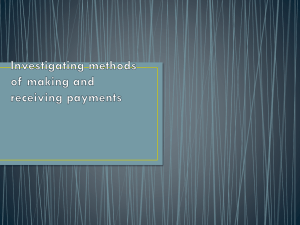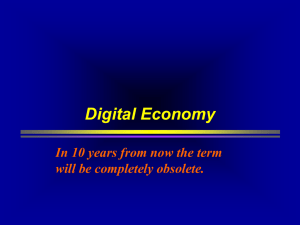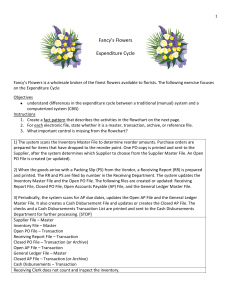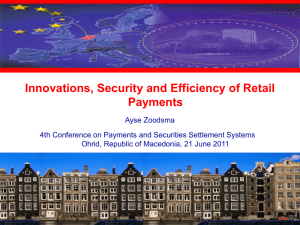E-commerce Payment Systems
advertisement
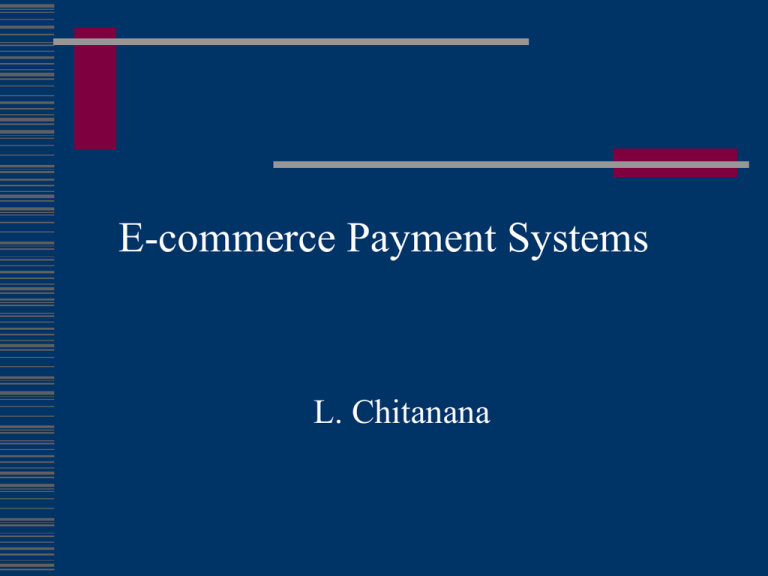
E-commerce Payment Systems L. Chitanana What is Online Electronic Payment An electronic payment system (EPS) also known as electronic currency, broadly speaking, refer to a transaction in the online exchange of funds; is a system of financial exchange between buyers and sellers in the online environment that is facilitated by a digital financial instrument (such as encrypted credit card numbers, electronic checks, or digital cash) backed by a bank, an intermediary, or by legal tender. What is Online Electronic Payment (contd.) Electronic Payment System is the basis for online payments, and online payments system development is a higher form of electronic payment. It means electronic payment may, at any time, through the Internet directly to the transfer, settlement and form e-business environment. Electronic Payments Benefits Electronic payments can benefit our business by: extending our customer base; boosting cash flow; reducing costs; enhancing customer service improving your competitive advantage. Five reasons why Electronic payments improve customer service Choice – like our competitors, we can offer a wide range of payment options Convenience – they remove the need for invoices, cheques, cash and BACs Credit – they may allow purchases that would otherwise be delayed Concessions – small discounts to encourage online purchases improve the perception of value Competitive Edge - if we don’t offer the full range of payment options but your competitors do, what does this say about your business? Five reasons why Electronic payments increase profitability Convenience – removing administrative resources required by invoices, cheques and cash Immediacy – credit cards enable instant purchasing (without delay) Improved cash flow – payment at the time of purchase reduces the pressures caused by 30-day invoicing Growth – open additional payment channels via the phone, mail order and Internet and increase your customer base. More customers mean more revenue. Competitive advantage – match and beat the services of your competitors and gain the edge Electronic Payment Methods Innovations affecting consumers, include credit and debit cards, automated teller machines (ATMs), stored value cards, and e-banking. Innovations enabling online commerce are e-cash, echecks, smart cards, and encrypted credit cards. These payment methods are not too popular in developing countries. They are employed by a few large companies in specific secured channels on a transaction basis. Innovations affecting companies pertain to payment mechanisms that banks provide their clients, including interbank transfers through automated clearing houses allowing payment by direct deposit. Available payment methods Credit Cards PayPal E-Check Wire Transfer C.O.D. Bank Transfer Gold Money Money Order or Cashiers Check by Mail Moneybookers WebMoney Transfer Western Union QuickPay E-Cash (Electronic-cash) Internet Payment E-cash and e-payment systems E-cash and e-payment systems also have the advantage of cash, mainly as follows: Anonymity; Not shadowing; Savings on transaction costs; Savings on transmission costs; Less risk; Pay flexibility; Prevent forgery and repeatability E-purse Internet Payment System E-purse is sporadic small payment transactions that is always used in conjunction with bank cards to help users complete the entire shopping process Electronic check (E_check) Internet Payment System Security Standards The security demands in EC activity specified as below: Safe transmitting of payment information and order information on internet, securing the data transmitted on network not be stolen by hacker; Separation of order information and personal account information, when the order containing the card holder’s account information is sent to the supplier, only the order information can be seen by the supplier, while other account information of card holder can not be read; Mutual identification between the cardholder and the supplier, to make clear the identities of the two sides of communication; under most circumstances the trust guarantee on network is provided by the third party. Online payment security Secure Socket Layer (SSL) Secure Electronic Transaction (SET) Public Key Software Infrastructure (PKI) Secure Electronic Transaction (SET) SET aims to solve the safety problem in electronic payment of credit card: Ensure the confidentiality of information and avoid being wiretapped when information is transmitted on line. Only the authorized legal person can get and decode the information; Ensure the entity of payment information, secure the data transmitted can be received fully without any alteration in the middle way; Attest the supplier and the customer, verify the validity of supplier, card holder and business activity which do business on the public network; Secure wide mutual operationality, ensure the communication protocol, message formatting and standard being adopted have the common adaptability. Thus various products of different supplier can be integrated on public interlinking networks. Online payment risk assessment Charge-backs – the risk of refunds on our merchant account; Forecast turnover figures – higher turnover can generate higher exposure; Average transaction size – if we sell very high value items (diamonds, cars) this will influence the risk analysis of our business; Time from payment to order fulfillment – The longer it takes to dispatch goods to a customer, the greater the risk of an order cancellation; Length of trading record – a start-up company presents more risk than a well established business; Business sector classification – different sectors have more or less risk associated with them (CDs can be resold but a flight needs the purchaser to turn up in person). Some banks have over 700 different business sector classifications. Safeguards you have in place – security checks like verifying address details or phoning customers who place large or repeated orders will reduce the perceived risk.
